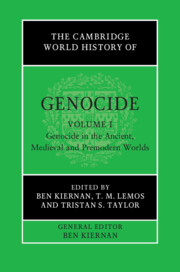Book contents
- The Cambridge World History of Genocide
- The Cambridge World History of Genocide
- The Cambridge World History of Genocide
- Copyright page
- Contents
- Figures
- Maps
- Tables
- Contributors to Volume I
- General Editor’s Acknowledgements
- General Editor’s Introduction to the Series
- Introduction to Volume I
- Part I Themes of Genocide through History
- Part II The Ancient World
- 6 Genocide in Ancient Israelite and Early Jewish Sources
- 7 Genocide in Ancient Mesopotamia during the Bronze and Iron Ages
- 8 Urbicide in the Ancient Greek World, 480–330 bce
- 9 Violence, Emotions and Justice in the Hellenistic Period
- 10 A Tale of Three Cities
- 11 Caesar’s Gallic Genocide
- 12 Genocidal Perspectives in the Roman Empire’s Approach towards the Jews
- 13 Religious Violence in the Later Roman Empire
- 14 Genocide, Extermination and Mass Killing in Chinese History
- Part III The Medieval World and Early Imperial Expansions
- Index
10 - A Tale of Three Cities
The Roman Destruction of Carthage, Corinth and Numantia
from Part II - The Ancient World
Published online by Cambridge University Press: 23 June 2023
- The Cambridge World History of Genocide
- The Cambridge World History of Genocide
- The Cambridge World History of Genocide
- Copyright page
- Contents
- Figures
- Maps
- Tables
- Contributors to Volume I
- General Editor’s Acknowledgements
- General Editor’s Introduction to the Series
- Introduction to Volume I
- Part I Themes of Genocide through History
- Part II The Ancient World
- 6 Genocide in Ancient Israelite and Early Jewish Sources
- 7 Genocide in Ancient Mesopotamia during the Bronze and Iron Ages
- 8 Urbicide in the Ancient Greek World, 480–330 bce
- 9 Violence, Emotions and Justice in the Hellenistic Period
- 10 A Tale of Three Cities
- 11 Caesar’s Gallic Genocide
- 12 Genocidal Perspectives in the Roman Empire’s Approach towards the Jews
- 13 Religious Violence in the Later Roman Empire
- 14 Genocide, Extermination and Mass Killing in Chinese History
- Part III The Medieval World and Early Imperial Expansions
- Index
Summary
In 146 BCE, Rome destroyed the cities of Carthage and Corinth, and in 133 BCE the Spanish stronghold of Numantia. The destruction of a city in the Greco-Roman world was a deeply symbolic act, and these particular acts of ‘urbicide’ – as we now call the intentional destruction of a city – were viewed by Greco-Roman authors as pivotal moments in Roman the expansion of Rome’s power. All three acts can be understood through the prism of retributive ‘conspicuous destruction’, designed to deter others from revolting against Rome’s power. In each case, Rome effaced individual responsibility for any perceived acts of disloyalty, and collectively punished the community through its effective elimination: after many perished in the siege and or sack of the city, the surviving population was enslaved, and the city itself destroyed – not to be re-inhabited by the survivors. When viewed through the prism of the definition of ‘genocide’ in the ‘Genocide Convention’, these actions of Rome could be viewed as intentional acts to destroy these civic communities ‘as such’, and thus warrant consideration as genocide. Of the three, Carthage stands out in the predetermination on the part of some at Rome – fueled by existential anxieties - to destroy the city, before an actual pretext existed.
Keywords
- Type
- Chapter
- Information
- The Cambridge World History of Genocide , pp. 278 - 308Publisher: Cambridge University PressPrint publication year: 2023



